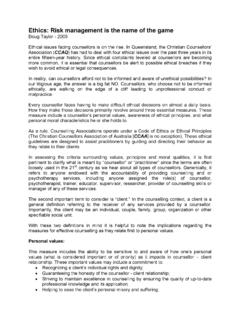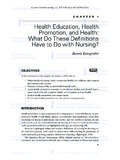Transcription of The New Directions Team Assessment (Chaos Index)
1 The New Directions team Assessment ( chaos index ) Background The New Directions team in the London Borough of Merton is one of twelve pilots from the Adults Facing Chronic Exclusion (ACE) national programme. The ACE Programme aims to ensure collective responsibility for inclusive services by taking an integrated approach to addressing services for adults facing chronic exclusion1. This national programme is a partnership across the departments of Work and Pensions, Health, Communities and Local Government, and the Home Office. The aim of the New Directions team is to provide an early intervention for residents from the London Borough of Merton who are not engaging with frontline services, resulting in multiple exclusion, chaotic lifestyles and negative social outcomes for themselves, families and communities.
2 The development of an agreed local chaos index to identify individuals or groups to target for the New Directions team was an outcome of the development of the new service. chaos index The development of the chaos index began by asking partners from the multi-agency steering group, who had been actively involved in the development of bidding to become a pilot site, for case studies of individuals whom they thought the New Directions team (NDT) would be serving. It was important from the start to understand the different perspectives of the multi-agency steering group members and who they considered the new team would actually be serving based on real case studies from local services.
3 Members of the steering group included Primary Care, Social Services, Mental Health Services, Housing, Youth Inclusion services, the Police, Drug and Alcohol services, Jobcentre Plus, the Learning & Skills Council and the volunteer bureau. Early discussions with the steering group combined with a review of the research evidence2 about people with chaotic lives who have multiple needs showed that a high proportion tend to have mental health problems, often in combination with substance use or personality disorder. Whilst the local case studies were being developed a brief review of the literature of people who did not engage or were rejected by mental health services was undertaken to identify key individual characteristics.
4 The multi-agency steering group were keen that the chaos index focused on behaviours. The local case studies were analysed to ascertain consistent behaviours across the case studies and to understand the level of impact of these behaviours. The first draft of the chaos index simply listed the behavioural criteria and anchor points. Feedback from the multi-agency steering group consisted of several semantic changes, the want to tier the index so engagement with front line services was the key to eligibility and to load the scoring for the two criterions for risk to others and risk from others . To ensure both reliability and consistency in Assessment it was agreed that when the NDT became operational the team manager would carry out all the chaos index assessments of referrals to the NDT team .
5 Piloting The chaos index was piloted across several of the agencies from the multi-agency steering group: the Police, mental health services, alcohol/drug services and the Youth Inclusion Services (for example, anti social behaviour team , youth justice team , 16+ team ). Each agency carried out the piloting as a desktop exercise based on existing knowledge of clients and considered clients they thought should be eligible for the NDT and people they thought would not. Agencies were also asked to comment on how easy it was to use, how understandable it was, whether there were criteria that were missing and whether the anchor points on the index were correct and the distance between them understandable/sensible.
6 A key aim of the piloting was to try and 1 HM Government (2006) Reaching Out: An Action Plan for Social Exclusion. London: Cabinet Office. 2 Schneider, J. (2007) Better Outcomes for the most excluded. Nottingham University. establish a threshold from the chaos index for eligibility to the NDT. Interestingly, the Youth Inclusion Services looked at the piloting for both the young person but also separately for the parents. The piloting identified that the chaos index was both easy to use and understandable however, there were concerns about people who were potentially marginal especially clients whom services considered the scoring of the individual could change in a short period of time.
7 For example, there was a concern that whilst a person might be leading a chaotic lifestyles resulting in current negative social outcomes they were scoring 2 on the engagement with frontline services criterion which would not make them eligible to continue the Assessment therefore not making them eligible for the NDT however, agencies thought that this could change and the person moves to scoring 3 or 4 within a short period of time thus making the individual potentially eligible for the service this will be addressed through ways of working between the NDT and other agencies. Through the piloting exercise there were several consistently high scoring criterions across agencies: risk to others, risk from others and drug/alcohol abuse.
8 In addition, members of the multi-agency steering group and several of the agencies who piloted the index suggested the name of the index should be changed to a less pejorative term. The name of the Assessment has now been changed to the New Directions team Assessment nobody wanted an individual who had been Assessment under the chaos index to see this as a badge of honour ! Outcome Through discussion of the piloting exercise at the multi-agency steering group a threshold for eligibility to the NDT has been set. The eligibility threshold will be reviewed over the next 6 months as referrals from local services and assessments are carried out to check that the threshold is correct and the team are targeting people who are not engaging with frontline services, resulting in multiple exclusion, chaotic lifestyles and negative social outcomes for themselves, families and communities.
9 Miles Rinaldi Head of Recovery and Social Inclusion David Linnell General Manager, Age-Related, Specialist and Addiction Services Mark Clenaghan Merton Service Director April 2008 New Directions team Assessment Instructions The New Directions team Assessment is used in assessing whether someone referred to the New Directions team is appropriate for the service. The Assessment will not be the only criterion to be used in determining service eligibility, and certain vulnerable groups of people will be given priority: care leavers, particularly those with multiple risk factors school exclusion young offenders prisoners facing release from HMP Wandsworth repeat offenders or former prisoners with drug/alcohol problems people with particularly pronounced housing difficulties The items in the Assessment are rated on a 5-point response format with 0 being a low score and 4 being the highest score, there are two criterion where 0 is the lowest score and 8 is the highest.
10 There are 10 criterions in total each with 5 anchor points. Criterion 1, engagement with frontline services, tests the basic eligibility for New Direction team , if a score of 0 - 2 is achieved then the person is not eligible to complete the Assessment or be considered for the team . Client Name: _____ Date of birth: _____ Address:_____ Telephone: HOME:_____ MOBILE: _____ Referrers name, organisation and contact details: _____ Person carrying out Assessment : _____ Date: _____ Select ONE statement that best applies to the person being assessed. Base all scores on the past one month. 1. Engagement with frontline services 0 = Rarely misses appointments or routine activities; always complies with reasonable requests; actively engaged in tenancy/treatment 1 = Usually keeps appointments and routine activities; usually complies with reasonable requests; involved in tenancy/treatment 2 = Follows through some of the time with daily routines or other activities; usually complies with reasonable requests; is minimally involved in tenancy/treatment 3 = Non-compliant with routine activities or reasonable requests; does not follow daily routine, though may keep some appointments.






